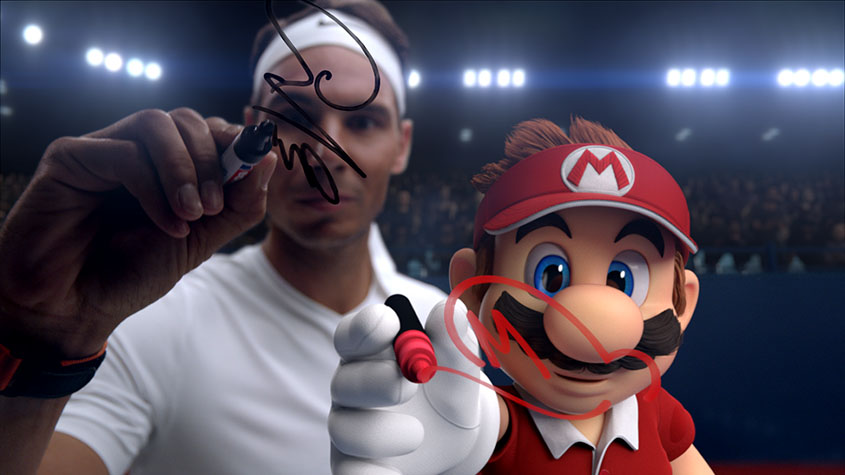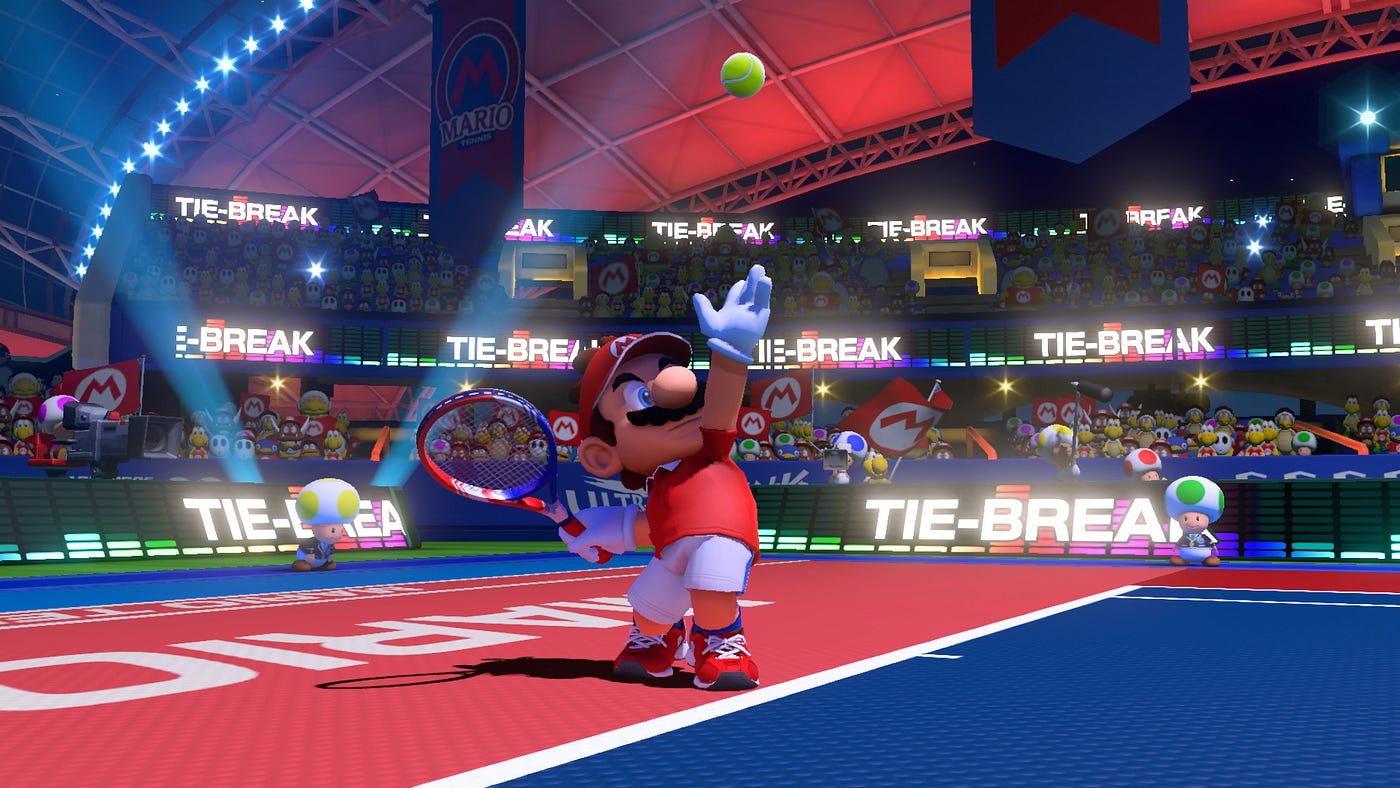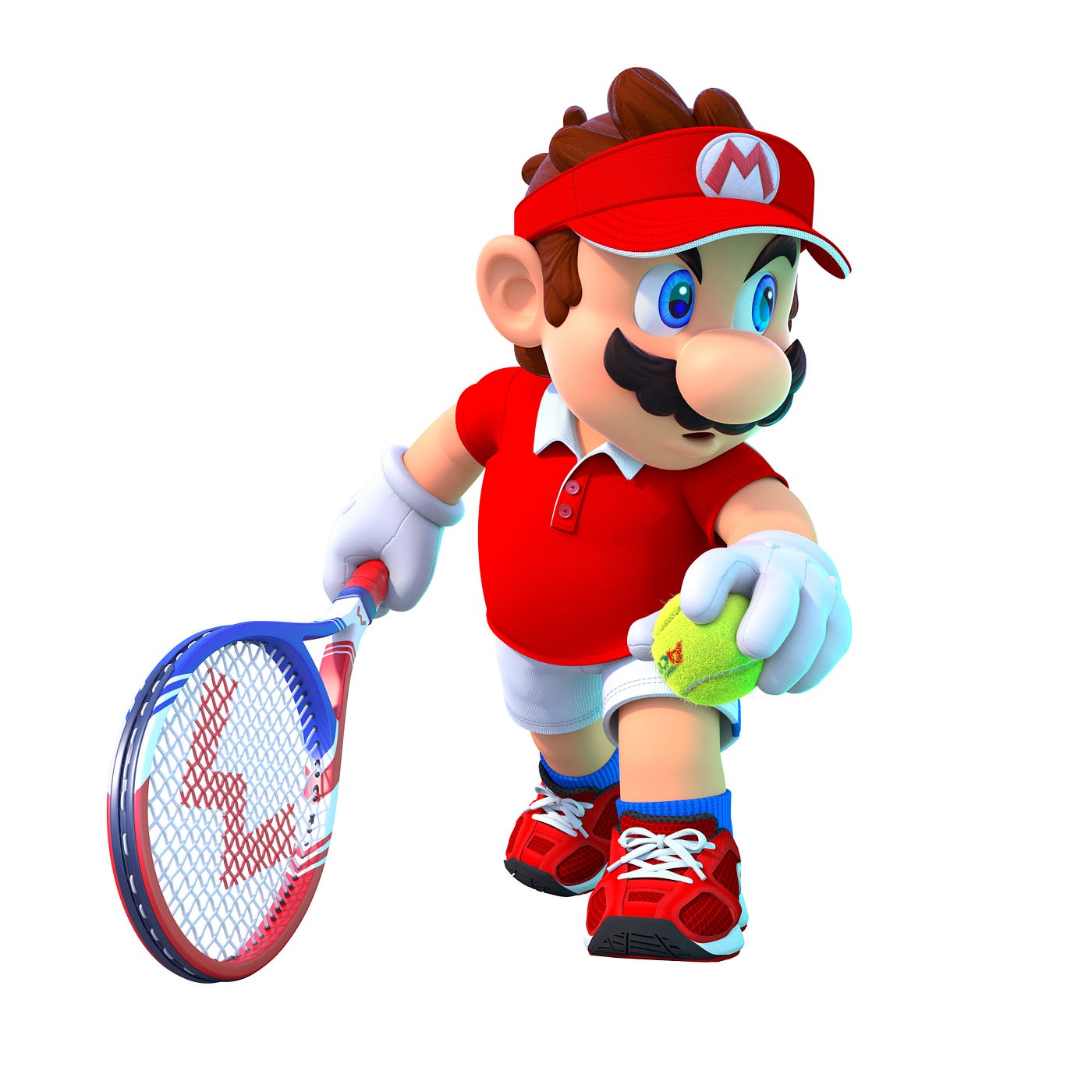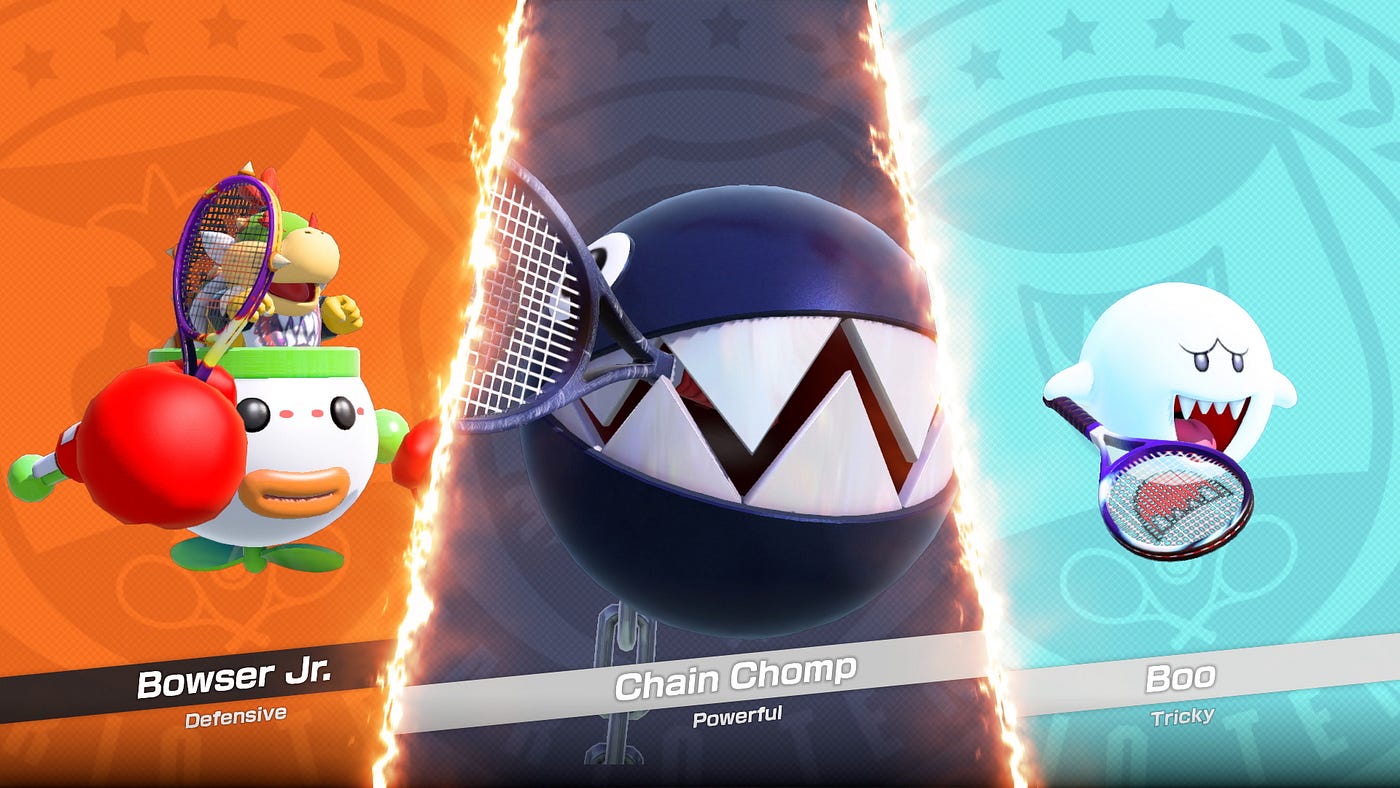Mario Tennis Aces Review
Tennis meets Smash Bros.?

This game was reviewed using an eShop code provided by Nintendo for Nintendo Switch.
Whenever I begin writing a review, I think it’s a good idea to plainly state where I’m coming from; the idea is that you will be more suitably-equipped to weigh my opinion, especially compared to other reviews you might read. So, when it comes to Mario Tennis Aces, I feel it’s important to point out that I have no experience with the previous “Mario Sports” titles. As a result, I’m unable to compare Mario Tennis Aces to those games — that might potentially be a dealbreaker for you, especially if you’re a longtime fan of these titles and you’re keen to understand how Mario Tennis Aces stacks up against its predecessors.
On the other hand, you might be like me: a first-timer to any kind of Mario sports title. Maybe you’ve bought a Switch and you’re thinking about which big Nintendo releases might tide you over until later in the year, when heavy-hitters like Super Smash Bros. Ultimate are released. If you’re in that camp, then this review might be more relevant for you.
Breaking the rules
It is worth pointing out, right from the beginning, that Mario Tennis Aces isn’t simply a tennis simulator wrapped in a Mario paintjob. My recent preview of the game provides further insight into the mechanics, but suffice it to say, an apparently one-sided match can rapidly turn on its head if the losing player effectively leverages special techniques like Zone Speed or Zone Shot. If you’re any kind of tennis purist, this might be a frustration. But I found these moves to be a welcome addition, primarily because they add an extra element of unpredictability to matches, and because they offer a chance at last-minute redemption; this is something that I found myself increasingly reliant on during my time in the Adventure Mode (we’ll get to that in a moment).

Where I found myself getting into trouble occasionally — and I’m very willing to admit that maybe I’m just not getting it — is with the core controls. Aside from the special techniques I mentioned above, there are a multitude of “regular” shot types that you can access. Pressing A, B, or Y will trigger a Topspin Shot, Slice Shot, and Flat Shot respectively. In addition, you can do a Lob or Drop Shot by moving the analogue stick up and down while also pressing X. Oh, and you can trigger a Trick Shot by moving the analogue stick and pressing X twice. If you double-tap A, B, or Y twice you’ll trigger a Power Shot. And if you hold A, B, or Y you’ll be able to do a Charge Shot. The special techniques (Zone Speed and Zone Shot) are triggered by using the shoulder buttons.
In theory, all of these different moves are useful. And I’d definitely say that it’s necessary to become familiar with a reasonable variety of moves in Mario Tennis Aces, especially as you progress further in Adventure Mode and particularly if you want to be competitive in online multiplayer. Repeating the same shots over and over again will enable your opponent to quickly learn — and react to — your play style.

In practice, I honestly found the controls to be confusing at times. In the heat of a match, I’d find myself accidentally triggering Trick Shots pretty often; these shots allow you to quickly jump from one side of the court to the other to hit a ball that’s out of reach. It’s an incredibly useful move, but it’s really easy to trigger by accident — it can be activated in two different ways, but one of them involves moving the left analogue stick and double-tapping the X button. If you’re in a heated match (which is a regular occurrence), it’s very easy to accidentally trigger Trick Shots all over the place. What would happen is that the ball might land close enough for me to hit it (without needing to leap in front of it), I’d move towards it and press X to lob it — only to accidentally leap right past it and miss the shot. It has actually taken some active thought on my part to avoid doing this. There are other shot types that I’ve accidentally triggered, too; I found this frustrating, not because of a missed shot per se, but because of a sense that my character was doing things I didn’t intend. That’s never a good feeling in any video game, especially one published by Nintendo. It really took time for me to adjust to the design here.
It’s definitely true that Camelot have packed a lot of different moves into relatively few buttons, and for advanced players that’s not a bad thing — as I said, it does provide you with a wide array of options during matches. Mastering these techniques will take time, and I suspect more advanced players will relish that challenge. But if you’re a more casual player (like me), you may find the path to be frustrating in ways that don’t always feel reasonable or satisfying. Again, it’s one thing to lose a match based on a sense that you simply didn’t read your opponent properly — it’s another thing to lose because you feel like you’re fighting with the controls.
It is worth bearing this in mind if you are putting Mario Tennis Aces in the same category as something like ARMS; that is, a game with strong casual appeal at one end that ramps up into a deeper experience at the other end. I’d say the ramp here is pretty steep, and you’ll find yourself hitting the deep end relatively quickly — especially if you are playing any mode other than the Swing Mode, which I discuss further below.
Story time
I have to admit that the ramp towards successfully grappling with Mario Tennis Aces’ rich move set is smoothed out to a fair degree thanks to the game’s Adventure Mode. Like similar modes in other multiplayer-centric games, Adventure Mode could largely be considered an extended tutorial of sorts. I don’t intend that as a criticism, either; given the strategic depth present here, it makes sense for the game to gradually introduce you to new concepts in a single-player context.
There is a plot here. The setup involves Wario and Waluigi crashing a tennis tournament, wielding the dangerously powerful Racquet of Bask, which originates from the ancient Bask Kingdom. Mario and Toad decide to venture to the Bask Ruins to find out more about the power behind this mysterious racquet.
Needless to say, I don’t think anyone will play Mario Tennis Aces for the plot (in the same way that I doubt gamers tend to clamour for new Mario platformers due to their extensive or intriguing stories). Sure, the plot setup provides something of a backdrop that helps explain the in-game world’s sudden tennis obsession, but ultimately, it’s not really required — what’s cool here is simply the idea that you’re moving around Mushroom Kingdom-esque locations, visiting numerous familiar settings, and playing tennis in them. Famous enemies and environments are used to awesome effect; facing a group of ravenous piranha plants that spit tennis balls at you, for example, is a clever example of the fusion between tennis mechanics and Mario’s wacky setting.

What’s even more interesting is that you aren’t always playing regular tennis matches. A great deal of the content in Adventure Mode consists of specific challenge stages, which generally require you to leverage a particular move or set of moves to complete the challenge. Needless to say, if you’re being asked to focus on a technique that you aren’t comfortable with, you’ll find yourself failing these stages over and over again; on the other hand, this sometimes-punishing practice in Adventure Mode really does prepare you for both single-player and online multiplayer matches.
There are also boss stages, and these are particularly fun; you’re usually in the position of weakening a boss and then performing a Zone Shot to hit a vulnerable spot on their body when they’re down. The bosses are often huge, larger-than-life creatures that fill the screen and demand both solid racquet and movement skills (often you’ll be hitting balls and dodging obstacles that fly around the court).
Dotted between these challenge and boss stage are, of course, “regular” tennis matches themselves. I’m using the quotation marks because in most matches, there are significant variables that will impact the experience. For example, in one game, a bunch of koopa troopers and goombas decided to run across the track (the koopa troopers were, hilariously, carrying folded towels from one location to another). Another match took place on a pirate ship, with the mast protruding right through the middle of the court — this mean that the ball might sometimes bounce off the mast and zigzag in any direction.
At a high level, it’s probably fair to say that most challenges, boss fights and regular matches boil down to a fairly similar set of scenarios — however, this is a tennis game, and I feel like the variety here will really test your knowledge of the various moves and techniques to the limit; this is especially true if, like me, you struggle to reliably execute some of these techniques. It can mean many repeated attempts at certain challenges.

There are other incentives for moving through Adventure Mode — Mario will “level up” (he has various stats that can be increased; as he levels up he’ll run faster, for example). In addition, you can acquire new racquets throughout the game which provide various benefits — but having said that, I didn’t find the progression system to be terribly compelling. There was never a point, really, where I felt that improved stats or more powerful racquets were going to make a major difference to my experience.
The most important reason to pursue Adventure Mode, I think, is that you’ll unlock new courts as you beat stages. As well as unlocking courts, it’s a lot of fun to progress through the world and uncover the next location — the themes are all based on significant areas within the Mushroom Kingdom, and there are some funny (and surprisingly) appearances and cameos throughout; it’s especially fun if you know your Mario universe characters well.
Crazy competition
Beyond Adventure Mode, there are numerous ways to play Mario Tennis Aces. And, thankfully, there are a number of ways you can tailor your experience depending on your skill level.
Swing Mode enables up to four players to get together on the court and it leverages the Joy-Con’s built-in motion controls. This mode is probably most comparable to playing something like WiiSports tennis, and I think it’s a genuinely great option for casual players. It’s also a pretty easy way to jump straight into the game if you have a few people around and you don’t want to put them through the much steeper learning curve involved with the regular controls.

Tournament Mode is your fairly typical ranked ladder, where a single player can take on either computer or human opponents. Taking on human opponents in this mode means you’ll be matchmaking online, which has positive and negative aspects to it. There is an option here, for instance, to play a tournament with a “simple” setting (this is where special moves like Zone Speed or Zone Shot are not included) — I wanted to try this, but I could never find anyone to play against. I only found online competitors when I played with the “standard” rules. For the most part, I didn’t have any problems (other than being far worse at the game than my opponents), although I did come across the occasional hiccup due to lag. Playing online in Mario Tennis Aces really does require a stable and fast internet connection, because the action itself is incredibly fast — it’s something to consider if your internet connection leaves something to be desired.
Finally, there’s a Free Play mode which pretty much allows you to set the rules — how many players, which court, the game rules, etc… Importantly, your progress in the Tournament Mode will govern the options you have available to you here when it comes to things like special outfits or unlockable characters.
Final thoughts
I have noticed some people summing up Mario Tennis Aces as something of a fighting game rather than a typical tennis game. I think that analogy makes a lot of sense; to some degree, Mario Tennis Aces actually reminds me of Super Smash. Bros in terms of the tournament progress, unlockable characters, and the simple-at-a-glance move set that is ultimately very tricky to genuinely master.
You won’t find a Smash Bros.-like breadth of content here though; the scope isn’t nearly that large. If you’re a dedicated player, you’ll be able to unlock everything reasonably quickly, and I’d say your ongoing enjoyment of the game is going to be highly dependent on the multiplayer aspect. And sure, playing tennis online is reasonably fun, but like Super Smash Bros., nothing beats frantic local multiplayer. If that’s something you’ll be able to do with Mario Tennis Aces, then I can easily recommend it. But if you’re relying on the Adventure Mode as the main experience here, you may find it lacking in terms of replayability; local multiplayer is going to be the thing that will keep you coming back to Mario Tennis Aces.
